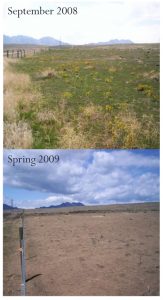Ehrenfeld Award 2012
Stower Beals, “The effects of prairie dogs (Cynomes spp.) on vegetation dynamics in Boulder, Colorado”
 Historically, prairie dogs (Cynomes spp.) have been considered essential to the health of natural grassland ecosystems by providing unique services and increasing vegetation community richness, evenness, and diversity. However, the persistence and return of black-tailed prairie dogs (Cynomys ludovicianus) to urban Boulder, Colorado may not result in the same ecosystem benefits historically associated with their presence. The urban landscape of Boulder presents prairie dogs with movement challenges unparalleled in natural landscapes, as well as suites of non-native plant species that have gained footholds in the region. This study sought to examine the role of the prairie dog in urban Boulder, Colorado to evaluate if the benefits to plant communities historically associated with their presence are maintained.
Historically, prairie dogs (Cynomes spp.) have been considered essential to the health of natural grassland ecosystems by providing unique services and increasing vegetation community richness, evenness, and diversity. However, the persistence and return of black-tailed prairie dogs (Cynomys ludovicianus) to urban Boulder, Colorado may not result in the same ecosystem benefits historically associated with their presence. The urban landscape of Boulder presents prairie dogs with movement challenges unparalleled in natural landscapes, as well as suites of non-native plant species that have gained footholds in the region. This study sought to examine the role of the prairie dog in urban Boulder, Colorado to evaluate if the benefits to plant communities historically associated with their presence are maintained.
The dataset for this analysis was comprised of 71 paired vegetation surveys and 156 additional unpaired surveys collected from 1997 to 2010. Absolute cover of each species was determined for every survey resulting in a database of more than 290,000 individual observations. Mixed measure linear models were used to compare data from occupied and unoccupied transects.
 Results of this comprehensive analysis suggested that vegetation richness, evenness, and species diversity were all significantly lower (p < 0.01) in areas occupied by prairie dogs. This analysis indicated that 12 species benefited from the presence of prairie dogs, while 16 species significantly declined in their presence (p < 0.05 for all). Certain invasive species, such asConvolvulus arvensis, are typically uncommon in Boulder (mean cover % = 1.38 ± 0.20 (SE)), but dominate areas occupied by prairie dogs (mean cover % = 16.38 ± 1.79). Analysis of plant community origins revealed the significant increase in the cover of introduced forbs in occupied areas (p < 0.01) and reduction in native grasses (p < 0.01). This study suggests that prairie dogs have a novel ecological role in Boulder, Colorado. In an urban landscape, prairie dogs may be facilitating the expansion of introduced species while reducing the abundances of species historically common to the area. Understanding how these changes to vegetation community compositions will affect ecosystem processes and services is necessary in order to develop informed management decisions that maximize the benefits of prairie dogs while minimizing the costs.
Results of this comprehensive analysis suggested that vegetation richness, evenness, and species diversity were all significantly lower (p < 0.01) in areas occupied by prairie dogs. This analysis indicated that 12 species benefited from the presence of prairie dogs, while 16 species significantly declined in their presence (p < 0.05 for all). Certain invasive species, such asConvolvulus arvensis, are typically uncommon in Boulder (mean cover % = 1.38 ± 0.20 (SE)), but dominate areas occupied by prairie dogs (mean cover % = 16.38 ± 1.79). Analysis of plant community origins revealed the significant increase in the cover of introduced forbs in occupied areas (p < 0.01) and reduction in native grasses (p < 0.01). This study suggests that prairie dogs have a novel ecological role in Boulder, Colorado. In an urban landscape, prairie dogs may be facilitating the expansion of introduced species while reducing the abundances of species historically common to the area. Understanding how these changes to vegetation community compositions will affect ecosystem processes and services is necessary in order to develop informed management decisions that maximize the benefits of prairie dogs while minimizing the costs.
Presentation Summary:
The majority of our current scientific knowledge regarding prairie dogs, and their effects on grassland ecosystems, has come from research predominantly conducted in natural or protected areas with minimal anthropogenic impacts. This body of knowledge is commonly relied upon by all interested parties when trying to developing policies and strategies regarding prairie dog management on public lands in the West. Our presentation demonstrated that some of the positive effects to plant species richness and diversity historically associated with the presence of prairie dogs are not found in an anthropogenic landscape. Furthermore, urban prairie dogs may be facilitating the expansion of introduced vegetation, which is a novel cost previously unassociated with their occupation. Although this presentation highlighted the different role that prairie dogs play in urban landscapes, more research is needed to understand subsequent changes to the ecosystem processes and services of these grasslands. Regardless of their landscape, prairie dogs provide unique services to grassland ecosystems; this presentation sought to explain that we must consider the landscape context of prairie dogs when developing management strategies.